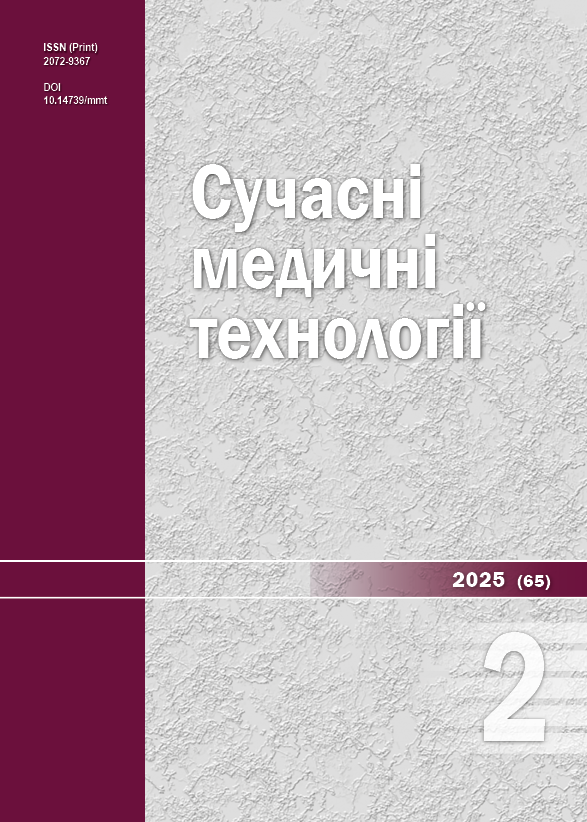A case of successful intensive care of severe sepsis in a newborn child
DOI:
https://doi.org/10.14739/mmt.2025.2.323125Keywords:
sepsis, newborn, plasmapheresisAbstract
Neonatal sepsis remains one of the key problems of perinatal medicine.
Aim of the study. To acquaint practitioners with the case of successful complex intensive care in a newborn child with severe sepsis using discrete plasmapheresis.
Materials and methods. The child was treated in the Department of Anaesthesiology and Intensive Care of Newborns of Zaporizhzhia City Children’s Hospital No. 5. The child underwent clinical and biochemical blood tests, microbiological, X-ray and ultrasound examinations using the hospital’s equipment.
Results. In a premature baby, the postoperative period after hernia repair was complicated by the development of necrotising enterocolitis. The child’s condition was close to critical due to the progression of toxemia, water and electrolyte disorders, acid-base imbalance, development of peritonitis, and multiple organ failure syndrome. For the purpose of extracorporeal detoxification, a discrete plasmapheresis session was performed. In order to sanitise the inflammation focus, the child’s abdominal cavity was drained from the left and right sides for washing with antiseptic solutions. After that, the child’s condition was stabilised, and an extended surgery with balanced multimodal anesthesia and neuroaxial block was performed. In post-operative period caudal blocks were performed twice daily. A second session of discrete plasmapheresis was conducted. Subsequently, immunosupplementation therapy, full parenteral nutrition, and combined antibacterial therapy according to the de-escalation principle were performed. The child’s condition was positive due to the complete regression of intoxication, intestinal paresis, and multiple organ failure. The result of complex intensive care using extracorporeal detoxification methods was positive.
Conclusions. The integration of extracorporeal detoxification methods into the comprehensive intensive treatment of severe sepsis in a newborn, in combination with de-escalation antibiotic therapy and immune replacement therapy, is likely to improve treatment outcomes.
References
Tsymbal AY, Kotlova YV. [Assessment of risk factors for osteopenia development in premature babies]. Modern medical technology. 2023;(4):27-36. Ukrainian. doi: https://doi.org/10.34287/MMT.4(59).2023.4
Strunk T, Molloy EJ, Mishra A, Bhutta ZA. Neonatal bacterial sepsis. Lancet. 2024;404(10449):277-93. doi: https://doi.org/10.1016/S0140-6736(24)00495-1
Procianoy RS, Silveira RC. The challenges of neonatal sepsis management. J Pediatr (Rio J). 2020;96 Suppl 1(Suppl 1):80-86. doi: https://doi.org/10.1016/j.jped.2019.10.004
Molloy EJ, Bearer CF. Paediatric and neonatal sepsis and inflammation. Pediatr Res. 2022;91(2):267-269. doi: https://doi.org/10.1038/s41390-021-01918-4
Gopal N, Chauhan N, Jain U, Dass SK, Sharma HS, Chandra R. Advancement in biomarker based effective diagnosis of neonatal sepsis. Artif Cells Nanomed Biotechnol. 2023;51(1):476-90. doi: https://doi.org/10.1080/21691401.2023.2252016
Glaser MA, Hughes LM, Jnah A, Newberry D. Neonatal Sepsis: A Review of Pathophysiology and Current Management Strategies. Adv Neonatal Care. 2021;21(1):49-60. doi: https://doi.org/10.1097/ANC.0000000000000769
Ko MH, Chang HY, Li ST, Jim WT, Chi H, Hsu CH, et al. An 18-year retrospective study on the epidemiology of early-onset neonatal sepsis - emergence of uncommon pathogens. Pediatr Neonatol. 2021;62(5):491-8. doi: https://doi.org/10.1016/j.pedneo.2021.02.005
Jyoti A, Kumar S, Kumar Srivastava V, Kaushik S, Govind Singh S. Neonatal sepsis at point of care. Clin Chim Acta. 2021;521:45-58. doi: https://doi.org/10.1016/j.cca.2021.06.021
Cantey JB, Lee JH. Biomarkers for the Diagnosis of Neonatal Sepsis. Clin Perinatol. 2021;48(2):215-27. doi: https://doi.org/10.1016/j.clp.2021.03.012
Rao H, Dutta S, Menon P, Attri S, Sachdeva N, Malik M. Procalcitonin and C-reactive protein for diagnosing post-operative sepsis in neonates. J Paediatr Child Health. 2022;58(4):593-9. doi: https://doi.org/10.1111/jpc.15774
Sawyer T, Billimoria Z, Handley S, Smith K, Yalon L, Brogan TV, et al. Therapeutic Plasma Exchange in Neonatal Septic Shock: A Retrospective Cohort Study. Am J Perinatol. 2020;37(9):962-9. doi: https://doi.org/10.1055/s-0039-1692184
Keith PD, Wells AH, Hodges J, Fast SH, Adams A, Scott LK. The therapeutic efficacy of adjunct therapeutic plasma exchange for septic shock with multiple organ failure: a single-center experience. Crit Care. 2020;24(1):518. doi: https://doi.org/10.1186/s13054-020-03241-6
Lee OPE, Kanesan N, Leow EH, Sultana R, Chor YK, Gan CS, et al. Survival Benefits of Therapeutic Plasma Exchange in Severe Sepsis and Septic Shock: A Systematic Review and Meta-analysis. J Intensive Care Med. 2023;38(7):598-611. doi: https://doi.org/10.1177/08850666231170775
Ten Barge JA, Zwiers AJ, Vermeulen MJ, Keyzer-Dekker CM, Simons SH, Staals LM, et al. Current anesthesia practice for preterm infants undergoing surgery for necrotizing enterocolitis: A European survey. J Clin Anesth. 2024;97:111508. doi: https://doi.org/10.1016/j.jclinane.2024.111508
Frawley GP, McCann AJ. Awake caudal anesthesia in ex-premature infants undergoing lower abdominal surgery: A narrative review. Paediatr Anaesth. 2024;34(4):293-303. doi: https://doi.org/10.1111/pan.14830
Portela F, Costa G, Cenicante T. Perioperative Ultrasound-Guided Continuous Caudal Epidural Analgesia in Newborns: A Case Series in a Tertiary Medical Center. Cureus. 2023;15(11):e48272. doi: https://doi.org/10.7759/cureus.48272
Couser DF, Veneziano GC, Nafiu OO, Tobias JD, Beltran RJ. Use of a Spinal-Caudal Epidural Technique for Abdominal Surgery in a Newborn With Noonan Syndrome and Severe Hypertrophic Cardiomyopathy. A A Pract. 2022;16(8):e01611. doi: https://doi.org/10.1213/XAA.0000000000001611
Popat H, Angiti R, Jyoti J, Webb A, Barnes E, Halliday R, et al. Continuous local anaesthetic wound infusion of bupivacaine for postoperative analgesia in neonates: a randomised control trial (CANWIN Study). BMJ Paediatr Open. 2022 Aug;6(1):e001586. doi: https://doi.org/10.1136/bmjpo-2022-001586
Iijima S. Exchange Transfusion in Neonatal Sepsis: A Narrative Literature Review of Pros and Cons. J Clin Med. 2022;11(5):1240. doi: https://doi.org/10.3390/jcm11051240
Weng J, Chen M, Fang D, Liu D, Guo R, Yang S. Therapeutic Plasma Exchange Protects Patients with Sepsis-Associated Disseminated Intravascular Coagulation by Improving Endothelial Function. Clin Appl Thromb Hemost. 2021;27:10760296211053313. doi: https://doi.org/10.1177/10760296211053313
Chang JC. Disseminated intravascular coagulation: new identity as endotheliopathy-associated vascular microthrombotic disease based on in vivo hemostasis and endothelial molecular pathogenesis. Thromb J. 2020;18:25. doi: https://doi.org/10.1186/s12959-020-00231-0
Nabih HK. Importance of immunoglobulin therapy for COVID-19 patients with lymphocytopenia. Bull Natl Res Cent. 2021;45(1):46. doi: https://doi.org/10.1186/s42269-021-00502-4
Downloads
Additional Files
Published
How to Cite
Issue
Section
License
Copyright (c) 2025 M. Yu. Kurochkin, A. H. Davydova, I. H. Denysenko, M. O. Makarova, O. M. Krupinova

This work is licensed under a Creative Commons Attribution-NonCommercial 4.0 International License.
The work is provided under the terms of the Public Offer and of Creative Commons Attribution-NonCommercial 4.0 International (CC BY-NC 4.0). This license allows an unlimited number of persons to reproduce and share the Licensed Material in all media and formats. Any use of the Licensed Material shall contain an identification of its Creator(s) and must be for non-commercial purposes only.














